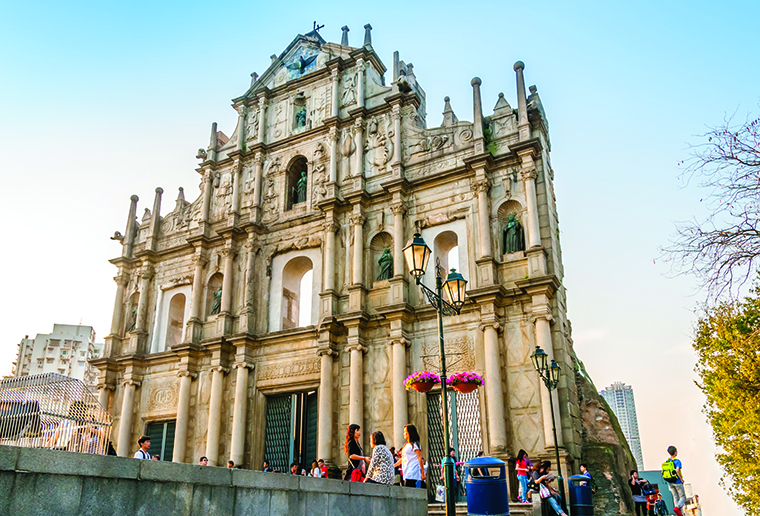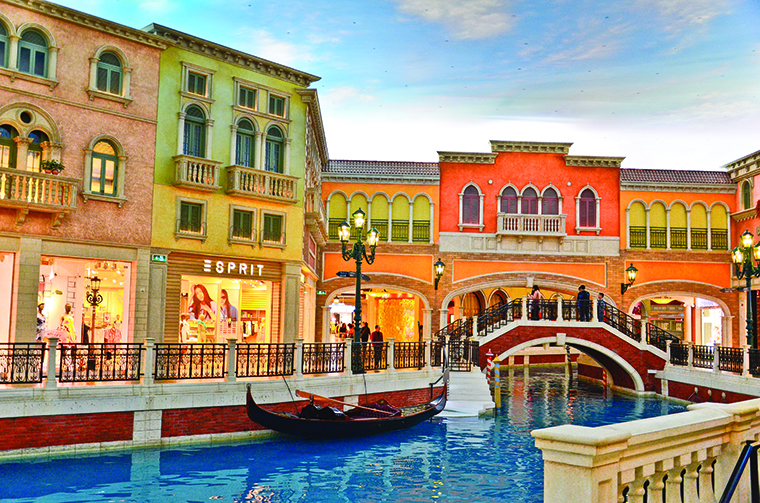“It’s like the Las Vegas of Asia,” people often say when describing Macau. The special administrative region of China has earned its reputation as a gaming hub, and the casinos rising up on the Cotai Strip and peninsula are adding fuel to the fire.
Gambling here is nothing new though. Over the decades, blackjack has mingled with baccarat in back alley games. It’s the fairly new high roller culture that elicits those Vegas comparisons—but this culture also stands in stark juxtaposition to the villages that surround the bright lights and luxury.

European Influences

Once a fisherman’s trading port, Macau was under the rule of Portugal for hundreds of years until 1999, when it was returned to China. The contrast that remains—between Eastern and Western culture, both past and present—provides the most compelling reason for visiting the tiny peninsula and neighboring islands. The Macau of today is a fascinating melting pot: Familiar Las Vegas landmarks house far more serious gamblers than our West Coast archetypes, while European influences take an Asian twist.
Take the culinary scene, for example. The Portuguese egg tart is arguably Macau’s most prominent dessert; sweet custard with a lightly bruleed top is set in a flaky pastry shell, and sold everywhere from restaurants and hotels to street corners (Lord Stow’s in Coloane is among the most highly rated). But for every egg tart, there’s also a pork chop bun, a southern Chinese street snack featuring fried meat sandwiched between a baguette, as well as traditional wet markets where locals can buy fresh meat and produce. It’s a combination of flavors and techniques that fall under the umbrella of Macanese cuisine.
In the region’s charming historic villages, you can also find a curious mix of old and new. Senado Square, part of the UNESCO World Heritage site encompassing the historic center of Macau, loosely takes its name from the Portuguese word for “senate.” European brands, like L’Occitane, are situated across from Asian cosmetic shops like Sa Sa, and crowds converge in front of St. Dominic’s, a late 16th-century church designed in a Portuguese colonial style.
From there, you’ll find landmarks in either direction that further emphasize Macau’s diversity. A-Ma temple, constructed in the 15th century to commemorate the fishermen’s sea goddess Mazu, is on the tip of the peninsula closest to Taipa and Coloane (the islands that border the Cotai Strip). On the opposite side of the square are the Ruins of St. Paul’s, which was originally the Church of Mater Dei in the early 1600s. The baroque-style landmark includes a facade adorned with sculptural elements like European ships and Chinese dragons. Meanwhile, the old “Happiness Street” (Rua da Felicidade)—Macau’s version of Amsterdam’s red light district, where prostitution and gambling once ran rampant—has a thoroughly enjoyable Chinese vibe, with open shops adorned in red and gold, and the scent of fresh-cooked food wafting through narrow pathways.
Viva Las Vegas

History echoes throughout all these streets on the peninsula, so it’s interesting to look up and see massive modern buildings bearing names familiar to American travelers.
Wynn Resorts introduced its hotel and casino on the peninsula in 2006, followed shortly thereafter by MGM Macau in 2007. Around that same time, the Cotai Strip was taking shape on the island side of the region. The Venetian was among the first to open in August 2007, paving the way for the Sands Cotai Central complex that includes a Sheraton, Conrad and Holiday Inn.
The fascinating cultural clash here lies largely in the gambling. While we’re accustomed to the rowdy, drunken crowds in Vegas, Macau’s casinos are refined and quiet. Slot machines and tables are corralled into a central area by high partitions that block off all distractions from the hotel; servers offer coffee, tea and water rather than cocktails so players can keep a clear head focused on the game.
A few elements do allow Americans to feel as if they’re visiting our Nevada counterpart: big-name hotels and designer boutiques dotting the Cotai Strip. The hotels are the height of luxury, with every imaginable amenity designed to keep guests entertained and happy. The Sheraton Macao Hotel, for example, has a VIP lounge for club members on the fourth floor with complimentary daily breakfast, hors d’oeuvres and afternoon cocktails; a spa and salon on the third floor; and three pool areas to keep cool in the humid weather. More hotels are slated to open later this year through 2016, including The St. Regis Macao and the Sands’ Parisian (housed in a replica of the Eiffel Tower).
Much like Vegas, the Cotai Strip is also an immensely walkable area. The Shoppes at Cotai Central, part of the Sands complex, have bridge access to the Shoppes at Venetian. The Venetian Macao is a near replica of the one on the Las Vegas Strip, though nearly twice the size, and houses several brands you’ll recognize: Calvin Klein, Tommy Bahama and Victoria’s Secret. The Four Seasons shops, also attached, have even more duty-free designer boutiques like Chanel, Valentino and Marc Jacobs. There are more than 650 stores that stay open until 11 p.m. Sunday through Thursday and midnight on Friday and Saturday.
The similarities end there, however. Everything from the gaming culture to the temperature—where Nevada is a dry desert, Macau is warm and tropical—encourages first-time visitors to discard any preconceptions of the region as a Vegas clone. It’s the epitome of a cultural convergence, and that’s the beauty of the city: Nearly every traveler can find something of interest, be it luxury shopping, historic ruins, Chinese markets or European architecture.
Travel Essentials
GETTING THERE: No visa is required to visit. EVA has flights from LAX; after one layover in Taipei, fly into Macau International Airport (just five minutes from the Cotai Strip).
CURRENCY: The Hong Kong dollar is taken almost everywhere. In the hotels and major shops, most world credit cards are accepted, but bring cash if you plan to purchase anything at the markets or in the the historic district.
—Written by Allison Hata




